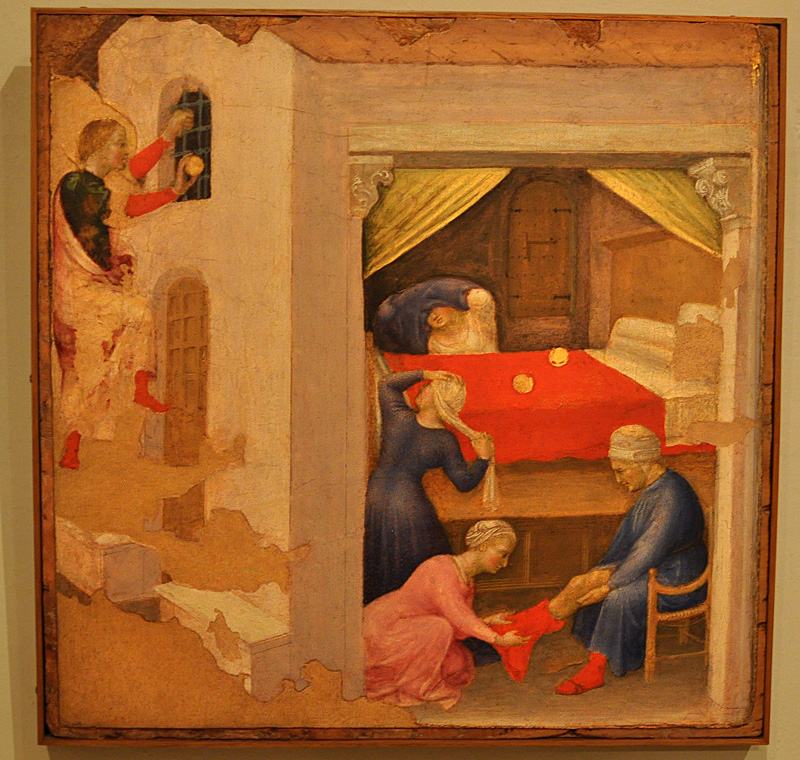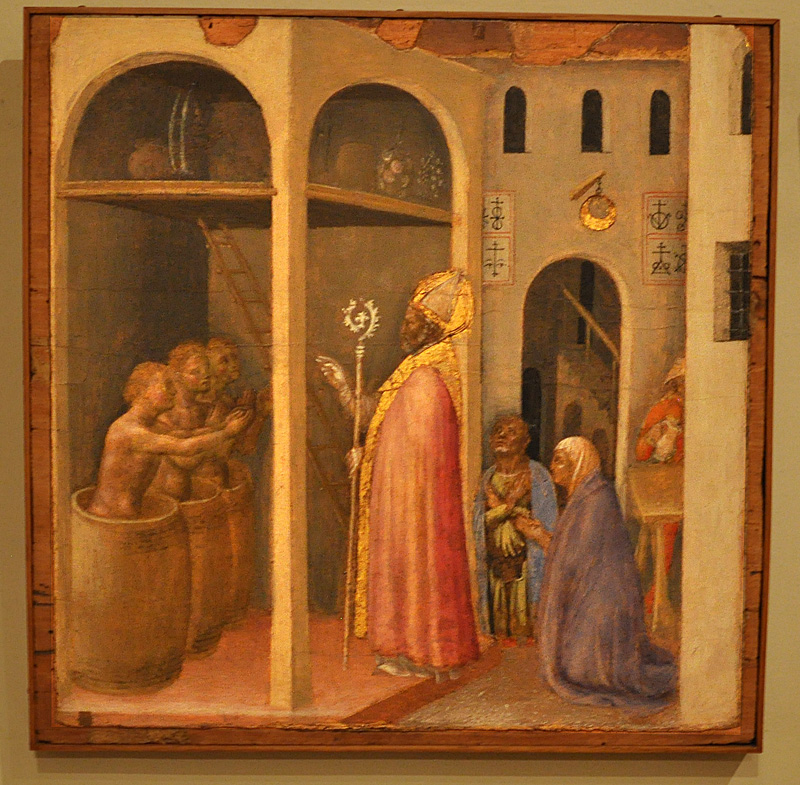Gentile da Fabiano, St. Nicholas Predella
1425
Tempera and gold on wood panel
Pinacoteca Vaticana, Rome
 The birth of St. Nicholas. This panel in the
predella
closely follows the pattern of Nativity of Mary images. The mother lies in a bed in a middle-class home while servants bathe the newly born child in a small basin. The rose garden on the left may also be a reference to the Virgin. (View this image in full resolution.)
The birth of St. Nicholas. This panel in the
predella
closely follows the pattern of Nativity of Mary images. The mother lies in a bed in a middle-class home while servants bathe the newly born child in a small basin. The rose garden on the left may also be a reference to the Virgin. (View this image in full resolution.)
 A youthful Nicholas throws three golden balls into the home of an impecunious father of three daughters. This image is the model for Bicci di Lorenzo's predella panel of ten years later. Please see my comments on that painting for a discussion of the iconography. (View this image in full resolution.)
A youthful Nicholas throws three golden balls into the home of an impecunious father of three daughters. This image is the model for Bicci di Lorenzo's predella panel of ten years later. Please see my comments on that painting for a discussion of the iconography. (View this image in full resolution.)
 Nicholas resuscitates the boys who had been cut up and pickled by an evil innkeeper. This episode is not in the Golden Legend, but it is the subject of a 12th-century play that in turn would have been based on earlier legends. It also serves as a model for the Three Boys episode in the Lorenzo predella. In both, Nicholas is no longer a youth but a bishop with a graying beard who performs the miracle at the urging of the boys' kneeling parents. Both images have a table on the far right where a man (the innkeeper?) pours something from a jug. (View this image in full resolution.)
Nicholas resuscitates the boys who had been cut up and pickled by an evil innkeeper. This episode is not in the Golden Legend, but it is the subject of a 12th-century play that in turn would have been based on earlier legends. It also serves as a model for the Three Boys episode in the Lorenzo predella. In both, Nicholas is no longer a youth but a bishop with a graying beard who performs the miracle at the urging of the boys' kneeling parents. Both images have a table on the far right where a man (the innkeeper?) pours something from a jug. (View this image in full resolution.)
 Basically this is the traditional way of picturing the miracle of the storm: Nicholas appears from above, represented more or less horizontally, while the winds attack the ship and imperil the sailors. But several innovations serve to emphasize the saint's role in spiritual salvation. Of the many images of this miracle that I have seen, this is the only one that pictures the sea bottom, on which the artist has placed a starfish and an old shipwreck. The figure to the left of the starfish is a mermaid or siren. (It is not unusual for medieval artists to turn the split tail of the mermaid into something more like lower limbs, as here.) In the Physiologus the mermaid or siren attracts sailors who then come to ruin:
Basically this is the traditional way of picturing the miracle of the storm: Nicholas appears from above, represented more or less horizontally, while the winds attack the ship and imperil the sailors. But several innovations serve to emphasize the saint's role in spiritual salvation. Of the many images of this miracle that I have seen, this is the only one that pictures the sea bottom, on which the artist has placed a starfish and an old shipwreck. The figure to the left of the starfish is a mermaid or siren. (It is not unusual for medieval artists to turn the split tail of the mermaid into something more like lower limbs, as here.) In the Physiologus the mermaid or siren attracts sailors who then come to ruin:
By the great sweetness of their extended song they charm the ears and senses of the sailors and put them to sleep. When they see the men lulled by most heavy sleep, they attack them and tear them to pieces.… Just so are those men deceived who delight in the charms of the world, in games and the pleasures of the theater. Disssipated by tragedies and various melodies and lulled to sleep, these men become the prey of their enemies (Curley, 23).
But crucially, this mermaid is pictured in the same supine pose as drowned figures in Noah's Ark images
(example). Her demise on the sea bottom expresses the saint's power against those who would lure men with tempting delights. His right hand blesses the sailors while his left holds not the usual crozier but a flaming torch. It is enlightenment that he brings the men, and in response they expeditiously trim the sails, jettison their worldly baggage and, as the story goes, are saved. (View this image in full resolution.)
Read more about images of St. Nicholas.
These panels were photographed at the Pinacoteca Vaticana by Richard Stracke, shared under Attribution-NonCommercial-ShareAlike license.
 The birth of St. Nicholas. This panel in the
predella
closely follows the pattern of Nativity of Mary images. The mother lies in a bed in a middle-class home while servants bathe the newly born child in a small basin. The rose garden on the left may also be a reference to the Virgin. (View this image in full resolution.)
The birth of St. Nicholas. This panel in the
predella
closely follows the pattern of Nativity of Mary images. The mother lies in a bed in a middle-class home while servants bathe the newly born child in a small basin. The rose garden on the left may also be a reference to the Virgin. (View this image in full resolution.)
 A youthful Nicholas throws three golden balls into the home of an impecunious father of three daughters. This image is the model for Bicci di Lorenzo's predella panel of ten years later. Please see my comments on that painting for a discussion of the iconography. (View this image in full resolution.)
A youthful Nicholas throws three golden balls into the home of an impecunious father of three daughters. This image is the model for Bicci di Lorenzo's predella panel of ten years later. Please see my comments on that painting for a discussion of the iconography. (View this image in full resolution.)
 Nicholas resuscitates the boys who had been cut up and pickled by an evil innkeeper. This episode is not in the Golden Legend, but it is the subject of a 12th-century play that in turn would have been based on earlier legends. It also serves as a model for the Three Boys episode in the Lorenzo predella. In both, Nicholas is no longer a youth but a bishop with a graying beard who performs the miracle at the urging of the boys' kneeling parents. Both images have a table on the far right where a man (the innkeeper?) pours something from a jug. (View this image in full resolution.)
Nicholas resuscitates the boys who had been cut up and pickled by an evil innkeeper. This episode is not in the Golden Legend, but it is the subject of a 12th-century play that in turn would have been based on earlier legends. It also serves as a model for the Three Boys episode in the Lorenzo predella. In both, Nicholas is no longer a youth but a bishop with a graying beard who performs the miracle at the urging of the boys' kneeling parents. Both images have a table on the far right where a man (the innkeeper?) pours something from a jug. (View this image in full resolution.)
 Basically this is the traditional way of picturing the miracle of the storm: Nicholas appears from above, represented more or less horizontally, while the winds attack the ship and imperil the sailors. But several innovations serve to emphasize the saint's role in spiritual salvation. Of the many images of this miracle that I have seen, this is the only one that pictures the sea bottom, on which the artist has placed a starfish and an old shipwreck. The figure to the left of the starfish is a mermaid or siren. (It is not unusual for medieval artists to turn the split tail of the mermaid into something more like lower limbs, as here.) In the Physiologus the mermaid or siren attracts sailors who then come to ruin:
Basically this is the traditional way of picturing the miracle of the storm: Nicholas appears from above, represented more or less horizontally, while the winds attack the ship and imperil the sailors. But several innovations serve to emphasize the saint's role in spiritual salvation. Of the many images of this miracle that I have seen, this is the only one that pictures the sea bottom, on which the artist has placed a starfish and an old shipwreck. The figure to the left of the starfish is a mermaid or siren. (It is not unusual for medieval artists to turn the split tail of the mermaid into something more like lower limbs, as here.) In the Physiologus the mermaid or siren attracts sailors who then come to ruin: